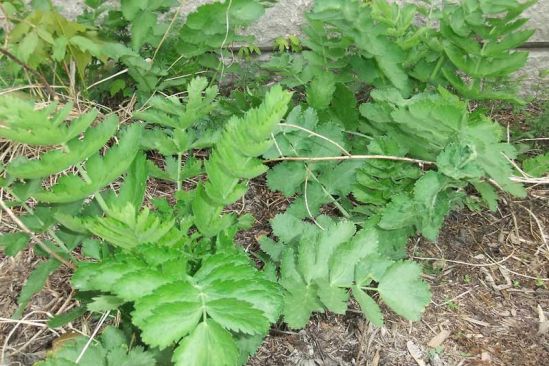Wilma Kenny | May 14, 2015
When the Sydenham high school addition was completed last year, part of the structure included an imposing stepped concrete retaining wall on the west side, looming over Mill Street. The three-foot deep terraces were filled with earth and planted.
Landscaping is the last step in a construction project, when time and money are usually running short. In my experience this often leads to compromises in quality and execution, regardless of what the original plan may have been.
By the end of last summer some of the plants had flourished, especially the grasses. But it was immediately apparent that the earth they were set in had not been the good quality sterilized potting soil and compost that an investment in a new planting deserves. Instead the fill appeared to have come straight from a field or roadside, rich with its own assortment of seeds.
This spring the steps are rampant with hardy perennials: dandelions, Manitoba maples, chicory and burdock. Many other plants are outlaws with their profiles on the province's noxious weed list: bull thistles, wild vetch so deep-rooted and fragile-stemmed that it’s almost impossible to eradicate by pulling, Queen Anne’s lace, quack grass, and worse. Much worse. Tall clumps of ragweed towered last fall above the rest of the growth, and will have reseeded. (Allergic to ragweed? Then you know why this plant’s on the list.)
Most alarming of all is the wild parsnip thriving everywhere along the steps, preparing to bloom and reseed this summer. Wild parsnip is closely related to giant hogweed. Its sap causes the skin to react to sunlight, resulting in intensely painful slow-healing sores, and is also possibly carcinogenic. Now even if someone tries to sort out this horticultural disaster, it will be a dangerous as well as difficult job.
Questions come to mind: why was poor quality weed-riddled fill used for these plantings? Why no mulch, which would have helped prevent at least some unwanted seeds from germinating? Why was there no provision to have someone with good plant recognition skills weed the steps thoroughly during the first summer? Did any thought go into the choice of plants used? A more careful selection and interplanting of dwarf evergreens, vines, various coloured day lilies and grasses would have filled the steps fully and attractively in a year or two, minimizing ongoing maintenance.
Instead the school now presents a noxious weed-ridden eyesore to anyone approaching from the west or heading down the main street into the village, an annoyance and hazard to both students and community.
Assuming the Limestone Board is responsible for the final product of their building project, what do they intend to do this summer to address this mess?
More Stories
- Province clarifies stance - Says Private Well Water Testing Will Continue
- Frontenac County Stays Internal for CAO - Appoints Kevin Farrell
- Addington Highlands Tax Bill Going Up 6.93%
- Perth Road United Church Donation to The Grace Centre
- 21 Years Of Dump Life Left At South Frontenac Waste Site
- Eclipse 2024 – Once In A Lifetime
- National Tourism Week
- NeLL Spring Open House and Anniversary Concert
- 25 years at Bishop Lake Outdoor Centre
- Grounds Contracts Down, Custodial Contracts Up In Central Frontenac

